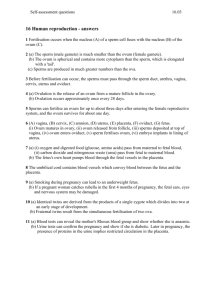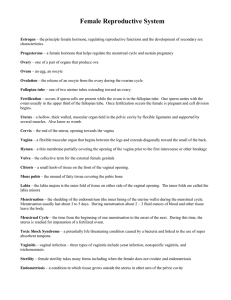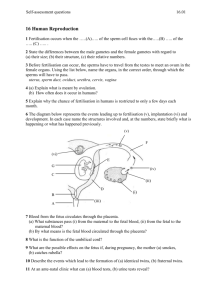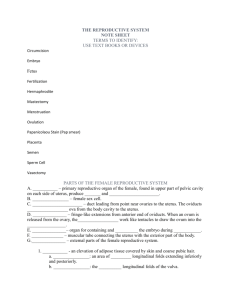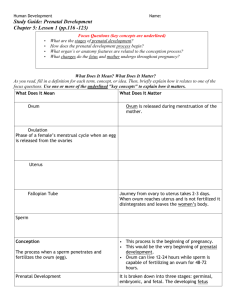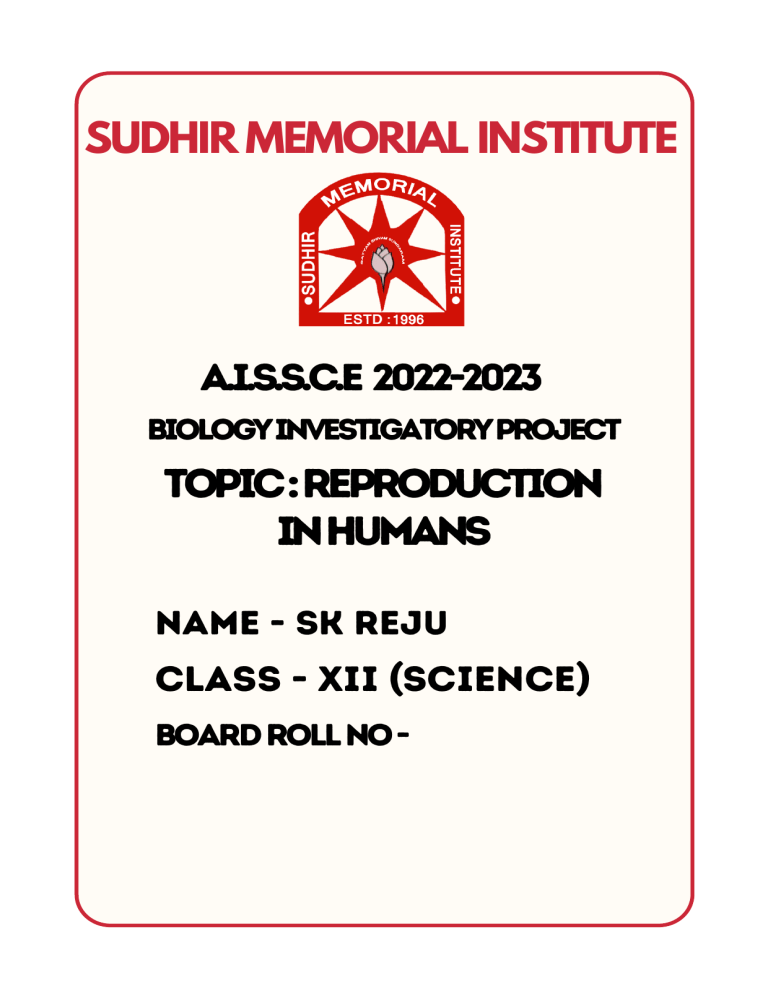
SUDHIR MEMORIAL INSTITUTE A.I.S.S.C.E 2022-2023 BiologyInvestigatoryproject TOPIC:Reproduction Inhumans NAME - SK REJU CLASS - XII (SCIENCE) BOARD ROLL NO - Index TOPICS Certificate Acknowledgement Human Reproduction : Introduction Male Reproductive System Female Reproductive System Gametogenesis Menstrual Cycle Fertilisation And Implantation Pregnancy And Embryonic Development Parturition And Lactation Conclusion Bibliography CERTIFICATE I certify that the investigatory project on the topic "Reproduction In Humans" has been done by Sk Reju of class XII under my supervision for the partial completion of A.I.S.S.C.E. Practical Examination 2022-2023. I do hereby wish them success for all the hard labour put in by them for the completion of the project Internal's Signature External's Signature Date: Date: ACKNOWLEDGEMENT I, Sk Reju student of class 12, Sudhir Memorial Institute hereby acknowledge that the project on the topic "Reproduction In Humans" has been done under the guidance of the teachers of the department of biology. I would also like to extend my gratitude to our principal sir, all my teachers and the school authority for their support. I would also like to thank my friends who helped me throughout in this project. Human Reproduction : Introduction Reproduction is the process of giving birth to their young ones which are identical to their parents. As we all are aware of, the process of reproduction in humans is sexual reproduction, which involves internal fertilization by sexual intercourse. The reproductive events in humans include formation of gametes (gametogenesis), i.e., sperms in males and ovum in females, transfer of sperms into the female genital tract (insemination) and fusion of male and female gametes (fertilisation) leading to formation of zygote. Male Reproductive System The male reproductive system is positioned in the pelvis region and comprises a pair of testes in addition to the accessory glands, ducts, and the external genitalia. A pouch-like structure known as scrotum encloses the testes located outside the abdominal cavity Each testis has close to 250 testicular lobules(compartments). These lobules comprise 1-3 seminiferous tubules wherein the sperms are produced. the lining of these tubules consists of two types of cells – male germ cells and sertoli cells The exterior of these tubules consist of spaces containing blood vessels and Leydig cells Male sex accessory ducts comprises rete testis, vasa efferntia, epididymis and vas deferens The urethra opens externally to the urethral meatus The male external genitalia, the penis is covered by foreskin which is a loose fold of skin The female reproductive system is made up of the internal and external sex organs, which consists of a pair of ovaries and oviducts, cervix, uterus, vagina and the external genitalia situated in the pelvic region. Along with the mammary glands, these female reproductive organs are combined both structurally and functionally in order to support the complete processes of reproduction including ovulation, fertilization, pregnancy, and the birth of a child. The female accessory ducts are constituted by the oviducts, vagina and uterus The section closer to the ovary is funnel-shaped infundibulum that possesses the fimbriae – finger-like projections facilitating the assimilation of ovum post ovulation The infundibulum directs to a wider section of oviduct known as ampulla. The last section of the oviduct, isthmus, has a narrow lumen joining the uterus Uterus is also known as the womb The cervical cavity is known as the cervical canal which goes onto form the birth canal along with the vagina Female external genitalia comprises – mons pubis, labia minora, labia majora, clitoris and hymen Mammary Glands are paired structures (breasts) that contain glandular tissue and variable amount of fat. Glandular tissue has 15-20 mammary lobes containing clusters of cells called alveoli. The cells of alveoli secrete milk, which is stored in the cavities (lumens) of alveoli. The alveoli opens into mammary tubules The tubules of each lobe join to form a mammary duct. Several mammary ducts join to form a wider mammary ampulla which is connected to lactiferous duct through which milk is sucked Gametogenesis Gametogenesis is the process of division of diploid cells to produce new haploid cells. In humans, two different types of gametes are present. Male gametes are called sperm and female gametes are called the ovum. Spermatogenesis In the male, immature germ cells are produced in the testes. At puberty, in males, these immature germ cells or spermatogonia are converted into sperms by the process of spermatogenesis. Spermatogonia are diploid cells that undergo mitotic division and their number increases. Primary spermatocytes undergo meiosis and produce haploid cellssecondary spermatocytes. These secondary spermatocytes undergo the second meiotic division to produce immature sperms or spermatids. These spermatids undergo spermiogenesis to transform into sperms. Various hormones like GnRH, LH, FSH and androgens are involved in stimulating spermatogenesis. Oogenesis In females, the oogonia are converted to the mature ovum. This process is called oogenesis. In the female ovary, millions of oogonia or mother cells are formed during fetal development. These mother cells undergo the meiotic cell division, the meiotic division rests at the prophase-I and lead to the production of primary oocytes. Primary oocytes are embedded within the primary follicles on the outer layer. Primary follicles get surrounded by more granulosa cell layer and forms secondary follicles. Secondary follicles then turn into the tertiary follicle. At the stage of female puberty, the primary oocytes present in the tertiary follicles complete meiosis and form secondary oocytes (haploid) and the polar body by unequal division. The tertiary follicle undergoes some structural and functional changes and produces mature Graafian follicle. Secondary oocyte undergoes second meiotic division to form an ovum. Ovum is released from the Graafian follicle during the menstrual cycle. The release of an ovum from the Graafian follicle is called ovulation. Ovulation is controlled by the female reproductive hormone which is stimulated by the pituitary gland. Menstrual Cycle In a life cycle, a woman’s body is vulnerable to a variety of changes. The cycle of these changes occur in women every month, positively for pregnancy is called the menstrual cycle. When an ovum is unfertilized, the uterus lining sheds and leads to a haemorrhage, called menstruation. In a girl, menstruation starts from the age of 10 to 15 when she attains puberty and this beginning is known as menarche. The ending of menstruation is known as menopause which takes place at the age range of 50. The first day of bleeding is marked as the first day of a menstrual cycle and the period from one menstrual cycle to another can vary from 28 to 30 days. Before discussing the different phases of the menstrual cycle, it is important to have a glimpse of the female reproductive system and organs involved in this cycle. They mainly include: A pair of ovaries that store, nourish and release ova. Uterus (womb), where implantation of a fertilised egg takes place and the foetus develops. Pair of the fallopian tubes connecting the ovaries and uterus. The count of the ovum in each ovary is decided and fixed before the birth of a girl. As she reaches puberty, hormones stimulate the development and release of one ovum per month. This continues till menopause. Phases Of Menstrual Cycle The menstrual cycle is divided into four phases, namely: 1. Menstrual phase: Day 1, uterus lining which is prepared for implantation starts to shed which lasts 3 to 5 days. 2. Follicular phase: In this phase, the primary follicle starts developing into a mature Graffian follicle. The endometrium also starts proliferating. The uterus starts preparation for another pregnancy. 3. Ovulatory phase: Mid-cycle phase, this is the phase in which ovulation takes place i.e., day 13-17. The end of the follicular phase along with the ovulation period defines the fertilisation period. 4. Luteal phase: It is the post-ovulation phase, where the fate of the corpus luteum is decided. If fertilisation occurs, pregnancy starts. If fertilisation doesn’t occur, it marks the onset of another cycle. Fertilisation And Implantation Fertilisation or fusion of gametes is the most vital event in the process of sexual reproduction as it results in new life. In humans, while the male gamete or sperm is motile; the female gamete or ovum is nonmotile. Therefore, for fertilisation to occur the two gametes must be brought together. This is achieved through insemination where the penis releases semen, filled with thousands of sperms, into the vagina. Interestingly, while half of the total sperms released carry the X-chromosome, the other half contain Y-chromosome. These sperms then rapidly move through the cervix, pass through the uterus and finally reach the ampullary-isthmic junction of the fallopian tube. In the meantime, the ovum, after completing the first meiotic division, gets released into the fallopian tube with the rupture of the Graafian follicle. Upon its release, the ovum begins to undergo the second meiotic division. However, the division does not go beyond the first phase. Interestingly, the ovum contains only the X-chromosome. Studies have shown that the ovum is filled with cytoplasm called the yolk or vitellus surrounded by a membrane called the vitelline membrane. This vitelline membrane is ensconced in another membrane called zona pellucida. Once it reaches the ampullary-isthmic junction, the ovum gets bombarded by several thousand sperms. However, only one sperm penetrates the zona pellucida and initiates the fertilisation process. After gaining entry through the zona pellucida, the acrosome present over the sperm’s nucleus, starts secreting enzymes that aids the sperm head to get through the ovum’s cytoplasm, while the sperm sheds its tail. The fertilised egg now resumes the remaining phases of the second meiotic division. About 3 days after fertilisation, the zygote contains nearly 8 to 16 cells and is called a morula. Over a period of two days, the morula descends down into the uterus and transforms itself into a blastocyst- a hollow ball composed of about 100 blastomeres which are arranged in two layers. The outer layer, called the trophoblast, eventually gives rise to the placenta while the inner layer consisting of a group of cells called the inner cell mass eventually differentiates to form the embryo. Interestingly, at the blastocyst stage, the zygote, now called the embryo gets attached to the uterus as the tropoblast grows outwards and penetrates the endometrial lining of the uterus. In response, the endometrial cells divide and start surrounding the blastocyst. This causes the blastocyst to sink and get implanted into the uterus. Once implantation has occurred, pregnancy gets initiated. Moreover, after implantation, the inner mass cells, get differentiated and begin to form the embryo. Embryo formation is thus a complex process that begins with fertilisation and ends with implantation of the embryo. Pregnancy And Embryonic Development Pregnancy is the term used to describe the period in which a fetus develops inside a woman's womb or uterus. Pregnancy usually lasts about 40 weeks, or just over 9 months, as measured from the last menstrual period to delivery. Health care providers refer to three segments of pregnancy, called trimesters. After fertilization, the zygote is formed. The zygote divides mitotically to form 2, 4, 8, 16 celled stages. These cells are known as blastomeres. Morula- Embryo having 8 to 16 blastomeres. The morula continues dividing mitotically and gets transformed to blastocyst. The outer layer of the blastocyst is called trophoblast and it gets attached to the uterine wall known as the endometrium. The implantation starts in the first week but gets completed by 2nd week. The inner cell mass of blastocyst forms embryo. Blastocyst differentiates further to embryonic and extraembryonic tissues. The implantation completes at the 2nd week. The interdigitated chronic villi of trophoblast and uterine cells form the placenta, which is the connection between the mother and the growing foetus. The placenta provides nourishment and oxygen to the embryo and helps in removing carbon dioxide and waste produced by the embryo. It also acts as an endocrine gland and secretes various hormones like hCG (Human Chorionic Gonadotropin), estrogen, progestogens, etc. for maintenance of pregnancy. Gastrulation starts in the 3rd week, the inner cell or embryo starts differentiating into three germinal layers, i.e. ectoderm, endoderm and mesoderm. These cells transform and get differentiated to all the tissues and organs, like nerve, blood, muscle, bone, digestive tract, etc. Ectoderm- nervous system, brain, spinal cord, epidermis, hair, nails, etc. Mesoderm- connective tissue, muscles, circulatory system, notochord, bone, kidney, gonads Endoderm- internal organs, stomach, liver, pancreas, bladder, lung, gut lining To sum up, the heart is the first organ to start working. After the 1st month of pregnancy, the heart develops. Limbs and digits develop in the 2nd month. By the end of 1st-trimester or 3rd month all the major organ systems develop. Genital organs are visible. During 5th month the embryo starts moving and hairs start appearing on the head. By the end of 2nd trimester (24 weeks or 6 months), eyelashes are formed, eyelids separate and the body gets covered with fine hair. By the end of the 9th month, the foetus fully develops and is ready for birth. Parturition And Lactation The average duration of human pregnancy is about 9 months which is called the gestation period. Vigorous contraction of the uterus at the end of pregnancy causes expulsion/ delivery of the foetus. This process of delivery of the foetus (childbirth) is called parturition. Oxytocin is the hormone responsible for this. The mammary glands of the female undergo differentiation during pregnancy and starts producing milk towards the end of pregnancy by the process called lactation. Conclusion Both the male and female reproductive systems play an important role in the process of reproduction. Other than these reproductive organs, there are sex hormones which are produced by the respective glands and are mainly involved in the development of secondary sexual characteristics and proper functioning of the reproductive tracts. Bibliography Biology class 12 : NCERT BYJU'S Vedantu Wikipedia

